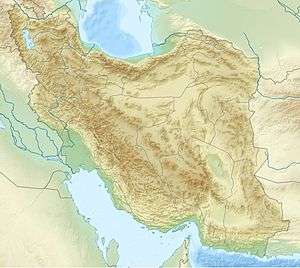A.S.P. Towers
| A.S.P. Towers | |
|---|---|
|
A.S.P. Towers | |
 | |
| General information | |
| Status | Complete |
| Address |
Corner of Kordestan and Hakim Highways Amir Abad - Yusef Abad |
| Town or city | Tehran |
| Country | Iran |
| Coordinates | 35°44′40″N 51°23′57″E / 35.74457°N 51.39914°E |
| Inaugurated | 1976 |
| Design and construction | |
| Civil engineer | Mojtaba Soltani |
| Main contractor | A.S.P. Construction Company |
| Designations | A.S.P, A stood for Assadi, S for Soltani, P for Panahpour |
A.S.P. Towers (also Kooy-e Nobonyad-e Vanak, Persian: ساختمانهای آ.اس.پ) are one of the most well-known skyscrapers in Tehran, Iran. It is located in the neighbourhood of Amir Abad and Yusef Abad in the corner of Kordestan and Hakim Highway.
It were among the first residential skyscrapers in Iran and have housed some of the most well-known Iranian figures over the years, as Amir-Abbas Hoveida, a prime-minister of Mohammad Reza Pahlavi.[1] The construction was carried out by A.S.P construction company. The construction is believed to have started in mid-1960s.[2] It consists of three towers which were named by A, B and C. The tower named A is the greatest and the most luxurious of the complex.[3]
The panoramic view of the three buildings includes Alborz Mountains, Damavand peak to the east and newly constructed Borj-e Milad (Milad Tower) to the west.They have been a landmark of Tehran since being completed in 1976 and was inaugurated by former empress of Iran Farah Diba in that year.
1979 revolution and lootings
After the 1979 Revolution in Iran, The A-tower was particularly targeted by the revolutionaries as it housed mostly business and political figures who either had fled Iran or lost their lives during the revolution. In all cases doors were crushed as the standard door locks were near-impossible to force-open or manipulate. The non-standard door frames to date indicate breaking in during the early day of the revolution.
The looting of property and cars went on for weeks following the chaos and lawlessness in early days of the Islamic revolution. The confiscated units themselves were later occupied by revolutionary families and later by some refugees from the Iran-Iraq war. The occupiers were eventually removed as law and order eventually returned after a number of years.
Notable residents
- Amir-Abbas Hoveida, Prime minister of Iran under Mohamad-Reza Pahlavi
- Issa Omidvar, Famous world explorer and First Asian explorer of Antarctica
- Colonel Hasan Jalali, Imperial Iranian Air Force, Royal flight instructor
Trivia
- A.S.P. Tower are in fact 24 storeys high not 22 as suggested by the elevators. The 23rd and 24th floors include penthouses not serviced by the lifts.
- Before the Islamic revolution sales of any units were subject to investigation and approval by Savak.
- The recently completed Tehran International Tower just behind A.S.P. complex has the title of Tallest residential building in Iran.
References
- ↑ Wikimapia. "A.S.P Towers". Retrieved 2013-04-10.
- ↑ Vguide. "Watch A.S.P. Towers Video (without video)". Retrieved 2013-04-11.
- ↑ Vguide. "Watch A.S.P. Towers Video (without video)". Retrieved 2013-04-11.
